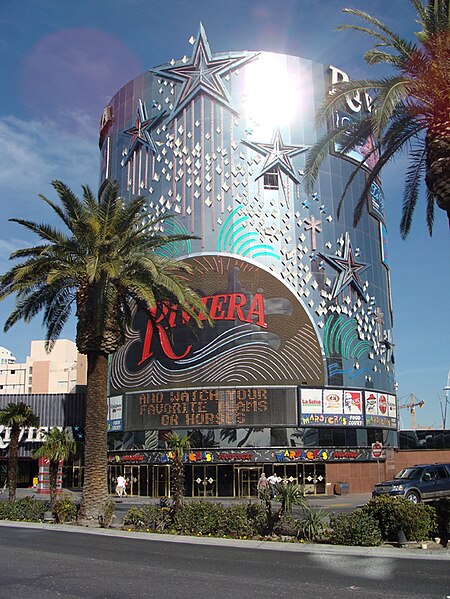The Stardust Resort and Casino was a casino resort located on 60 acres (24 ha) along the Las Vegas Strip in Winchester, Nevada. The Stardust was conceived by Tony Cornero, and construction began in 1954. Cornero died in 1955, and the project was taken over by his brother. The Stardust had numerous creditors, and construction was stopped in 1956, when the project ran out of money.
Rella Factor, the wife of John Factor, bought the Stardust in January 1958, and finished construction. The Stardust opened on July 2, 1958, as the world's largest hotel. It had 1,065 rooms located across six motel structures, and included a 16,500 sq ft (1,530 m2) casino. An adjacent hotel-casino, the Royal Nevada, became part of the Stardust in 1959, with its casino converted into Stardust convention space. A nine-story hotel addition was completed in 1964. The resort operated the off-site Stardust Country Club and the Stardust International Raceway during the 1960s, and in 1972, it became the first resort on the Las Vegas Strip to open an RV park for guests, a concept that proved to be popular.
After several ownership changes, Argent Corporation purchased the Stardust in 1974. Argent added a sportsbook that would later become a popular attraction for the Stardust. In 1976, a state investigation found that a skimming operation was occurring at the Stardust and at Argent's other properties. The Stardust was sold again in 1979, to Al Sachs and Herb Tobman, both of whom had previously served as general managers for the resort. Another investigation determined in 1983 that skimming was occurring at the Stardust again. The Nevada Gaming Commission concluded that Sachs and Tobman had failed to prevent the skimming, and the men agreed to sell the Stardust.
The Boyd family purchased it in 1985, and would retain ownership for the remainder of the resort's history. The Stardust had been one of the few Las Vegas Strip resorts without a high-rise hotel tower, until the Boyds added a 32-story tower in 1990. The original Stardust motel structures were demolished around 2000, to make way for an expansion of the resort, although the nine-story tower was kept. In its final years, the Stardust included an 85,000 sq ft (7,900 m2) casino and 1,552 hotel rooms. It was small compared to newer resorts on the Las Vegas Strip, and revenue fell during its last years.
Boyd Gaming announced in January 2006 that it would close and demolish the aging Stardust to build a new project, Echelon Place, on the site. The Stardust closed on November 1, 2006, and the two hotel towers were imploded on March 13, 2007. The resort had a popular roadside sign, which was given to the city's Neon Museum. Construction on the Echelon project was halted in 2008, because of financial problems caused by the Great Recession. Genting Group bought the Echelon project in 2013, and announced plans to finish it as Resorts World Las Vegas. It opened in 2021, after several delays.
The Stardust hosted numerous entertainers and shows throughout its history. At its opening, it debuted Lido de Paris, which featured topless showgirls. The show continued playing until 1991, when it was replaced by a modernized show known as Enter the Night. Wayne Newton was the resort's resident headliner from 2000 to 2005. Other entertainers who performed at the Stardust include Don Rickles, Tim Conway, Harvey Korman, Siegfried & Roy, and Steve and Eydie.
In 2020, Boyd launched its Stardust Social Casino online game. The following year, Boyd partnered with FanDuel to launch Stardust-branded online casinos in Pennsylvania and New Jersey.







